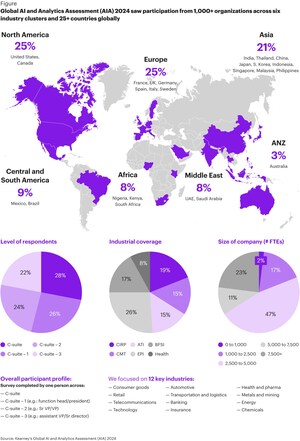CHICAGO, March 11, 2021 /PRNewswire/ -- During the initial shock of the COVID-19 pandemic (Q2 2020 to Q3 2020), a handful of companies grew revenues twice as fast as their industry peers while sustaining vastly higher total shareholder returns. What set them apart? Strategic command of their third-party spend―purchases of goods and services from suppliers, which consume (on average) 50 percent of revenue in manufacturing companies and 30 percent in service companies.
This was among the findings in The power of third-party economics, the 2020 iteration of the Assessment of Excellence in Procurement (AEP) benchmark study that Kearney first launched in 1992. The 2020 global study analyzed 370 companies, all with at least $2 billion in annual revenues.
Leaders (7 percent of the companies studied) generated nearly five times higher total shareholder return and 33 percent higher average margins compared with their peers, which were designated as "aspirants" (8 percent), "the pack" (50 percent), and "strugglers" (35 percent). Leaders also felt confident enough to ramp up their efforts on strategic imperatives such as sustainability, product and service innovation, and supplier diversity (for example, green suppliers and minority- and women-owned businesses). Leaders' vastly superior results stem from what the study's authors call third-party economics―looking beyond immediate cost considerations toward creating long-term structural advantages across the company's supply chain.
"C-suites that neglect the growing gap between their own company and leaders that are pursuing third-party economics will end up, in effect, subsidizing more advanced competitors that can draw from the same supply base on increasingly advantaged economic terms," cautioned Yves Thill, a Kearney partner who led the study. "This could result in competitive disadvantage for companies that accept the status quo."
One example of how the leaders work differently can be found in their technology investments. "We found that a few companies are shifting away from making massive investments in major ERP systems, which require a herculean effort to implement and have often failed to deliver the promised benefits," observed Elouise Epstein, a Kearney vice president and co-author of the report. "Leaders are moving toward much lower-cost innovation partnerships with early-stage digital start-ups. This can make digital capability development much faster and far more agile, at a fraction of the cost," she adds.
Other distinguishing characteristics of the leaders identified in the study include the following:
- 3x more likely to have long-term category strategies
- 3x more likely to report strategic value from supplier diversity initiatives
- 4x more likely to have formal supplier relationship management (SRM) programs with key strategic suppliers
- 7x more likely to have cross-functional SRM governance
Companies with at least $2 billion in annual revenues are invited to benchmark against their peers by participating in the AEP.
About the study
The 2020 AEP is the 11th in a series that began in 1992. With its focus on leadership practices in supply management and resulting business performance, the AEP is the gold standard of supply management organization benchmark studies. The 2020 benchmarking set includes 370 companies across a broad range of industries in the Americas, EMEA, and the Pacific region.
To read the full report, please click here.
About Kearney
As a global consulting partnership in more than 40 countries, our people make us who we are. We're individuals who take as much joy from those we work with as the work itself. Driven to be the difference between a big idea and making it happen, we help our clients break through. For more information, visit www.kearney.com.
Media contacts
Ryan Dicovitsky and Ellie Johnson
Dukas Linden Public Relations
[email protected]
SOURCE Kearney

Related Links
WANT YOUR COMPANY'S NEWS FEATURED ON PRNEWSWIRE.COM?
Newsrooms &
Influencers
Digital Media
Outlets
Journalists
Opted In






Share this article